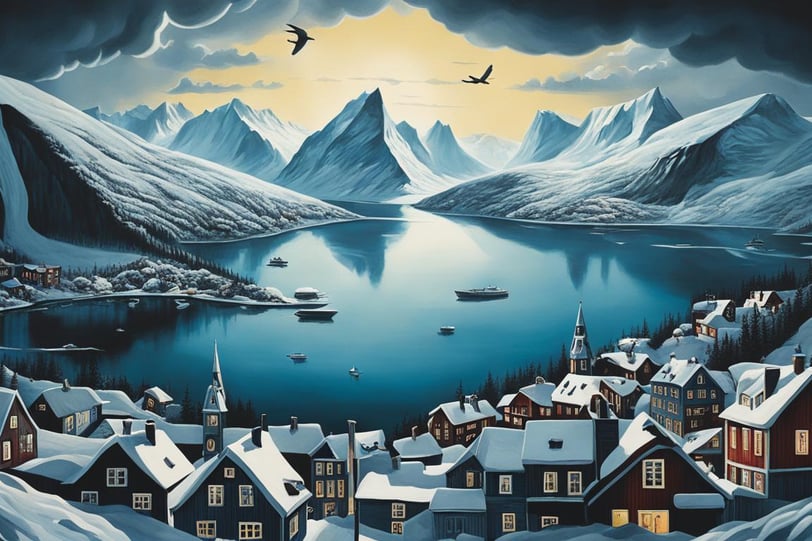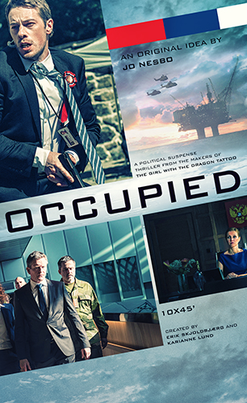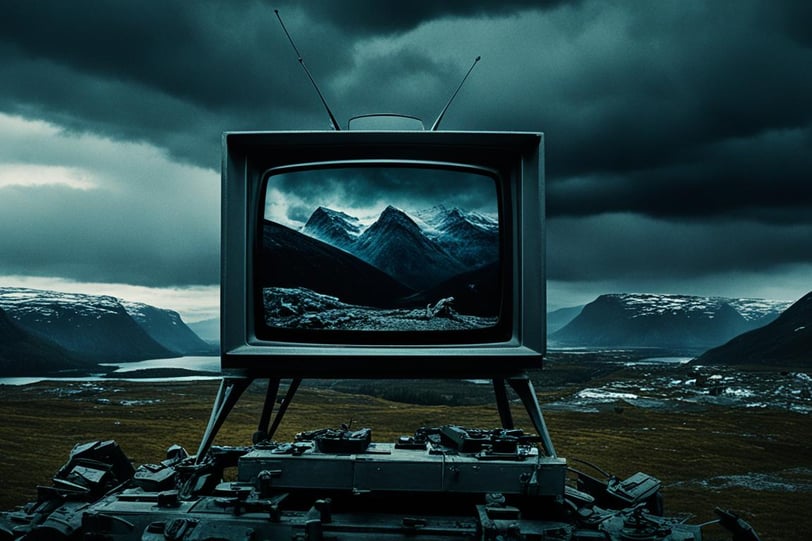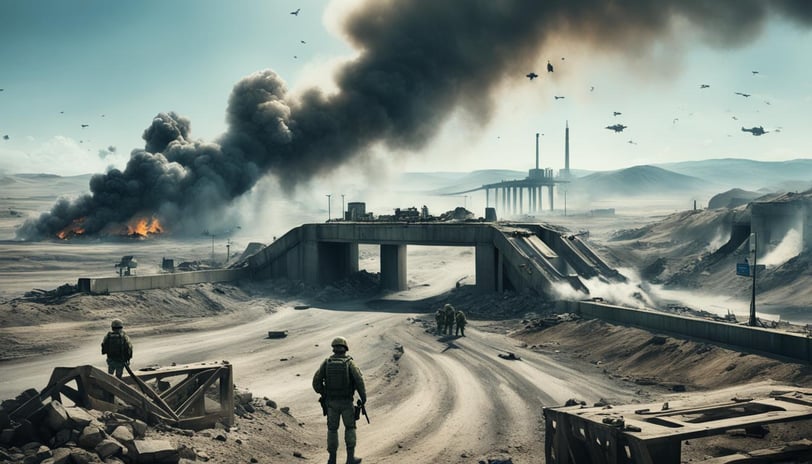Norway’s Occupied: Binge-Worthy Three-Season TV Thriller Turned Prophetic Amid Russia’s Attack on Ukraine
Few series manage to blend gripping drama with eerie geopolitical prescience quite like Occupied (Okkupert). This Norwegian thriller, spanning three seasons was originally conceived by renowned crime novelist Jo Nesbø. The show offers a chilling depiction of a hypothetical Russian occupation of Norway, igniting intense discussions and reflections on contemporary global politics.
Released in 2015, Occupied has gained renewed relevance in light of recent geopolitical events, particularly Russia's invasion of Ukraine. The show’s premise—Norway’s abrupt shift to eco-friendly energy leading to a covert Russian occupation—resonates strongly against the backdrop of modern-day conflicts. This connection between fiction and reality makes Occupied not just a must-watch thriller but a prophetic commentary on international relations.
This article delves into all things you need to know about the TV series Occupied, beginning with a spoiler-free overview, an in-depth look at the talented cast, and uncovering Easter eggs and hidden details that enhance the narrative.
Additionally, we explore the meticulous production and behind-the-scenes insights, the series' reception among audiences and critics, and the striking parallels with Russia's real-world aggression in Ukraine. Finally, we address the lingering question on many fans' minds: Will there be an Occupied Season 4? Join us as we unravel the layers of this remarkable series and its relevance in today’s geopolitical landscape.
Spoiler-Free Overview of Occupied
Occupied is set in a near-future Norway, where Prime Minister Jesper Berg (played by Henrik Mestad) announces a bold plan to halt all fossil fuel production in favor of environmentally friendly alternatives. This decision is met with stark opposition from both the European Union and Russia, who rely heavily on Norwegian oil and gas. As a result, Russia, with tacit EU approval, launches a soft invasion under the guise of restoring oil production, effectively placing Norway under occupation.
The series masterfully navigates the ensuing political, social, and personal turmoil. It explores themes of sovereignty, resistance, and the moral complexities faced by individuals and governments under foreign control.
One of the most compelling aspects of Occupied is its plausibility. The show’s creators went to great lengths to ensure the scenarios depicted were grounded in real-world political dynamics, lending an unsettling authenticity to the narrative. The series does not rely on over-the-top action sequences; instead, it focuses on the psychological and societal impacts of the occupation, making it a thought-provoking watch.


Cast and Characters of Okkupert
Occupied boasts a talented ensemble cast, each delivering powerful performances that bring depth to their characters and the story.
Henrik Mestad’s portrayal of Prime Minister Jesper Berg is central to the series. Berg is an idealistic leader whose radical environmental policies trigger the occupation. Mestad captures the complexity of a man torn between his vision for Norway’s future and the harsh realities of geopolitical pressures.
Eldar Skar plays Hans Martin Djupvik, a member of the Norwegian secret police who becomes embroiled in the occupation’s moral ambiguities. Skar’s performance is nuanced, portraying Djupvik as a man struggling to balance duty with loyalty to his country. His character’s evolution is one of the show’s most compelling arcs.
Ingeborga Dapkūnaitė’s role as Russian ambassador Irina Sidorova is both chilling and captivating. Sidorova is depicted as a shrewd and calculating figure, orchestrating the occupation with a cold, strategic precision. Dapkūnaitė’s performance adds a layer of sophistication to the show’s portrayal of political machinations.
Thomas Eriksen, played by Vegar Hoel, is a journalist who risks everything to expose the truth about the occupation. Hoel’s portrayal is both passionate and relentless, embodying the spirit of resistance and the quest for truth. His interactions with other characters highlight the personal stakes involved in the broader political conflict.
Ane Dahl Torp plays Bente Norum, a restaurateur whose business flourishes under the occupation due to the influx of Russian patrons. Her character’s journey reflects the broader societal changes and moral compromises faced by ordinary citizens during the occupation.
In addition to the main characters, Occupied features a strong supporting cast that brings depth and complexity to the series. Selome Emnetu plays Hilde Djupvik, the wife of Hans Martin Djupvik. Her character provides a personal perspective on the toll the occupation takes on families, adding emotional weight to the narrative. Ellen Birgitte Winther’s role as Wenche Arnesen, the head of police who secretly aids the resistance while battling cancer, adds a poignant dimension to the storyline.
Other notable performances include Maria Bock as Astrid Berg, the Prime Minister's wife, and Stig R. Amdam as the stern and pragmatic military leader, Harald Vold. Each of these characters, along with many others, enriches the series by providing diverse perspectives on the occupation, from the halls of political power to the struggles of everyday citizens. This ensemble cast ensures that Occupied offers a comprehensive and gripping portrayal of a nation under siege.


Promotional poster for Occupied
Easter Eggs (Spoiler Alert!)
Occupied is filled with subtle references and hidden details that enrich the viewing experience for attentive audiences. These Easter eggs not only pay homage to real historical events and cultural icons but also enhance the narrative's depth, connecting it to broader geopolitical themes and Norway's own historical context.
1. A Quisling Reference
Although the series never explicitly mentions Vidkun Quisling, the leader of Norway's collaborationist government during World War II, the show's premise of a foreign occupation inevitably evokes comparisons. This subtle nod serves as a historical parallel, highlighting how easily sovereignty can be compromised under certain conditions.
2. Cold War Echoes
The fear of Russian aggression and the tension of living under occupation resonate strongly with the Nordic audience. This is particularly relevant given Finland's historical policy of neutrality during the Cold War, known as "Finlandization," where the country maintained independence but had to align its policies with the Soviet Union to avoid conflict. This historical backdrop adds layers of realism and tension to the series.
3. Norwegian Mythology
Occupied weaves in elements from Norwegian literature and mythology. For example, the show’s exploration of Norway’s identity and its environmental stance can be seen as a modern retelling of Norse myths about nature and survival. The narrative often alludes to the deep connection between Norwegians and their natural environment, emphasizing themes of preservation and resistance.
4. Nordic Noir Influence
The series incorporates stylistic elements from Nordic noir, a genre characterized by its dark, moody atmosphere and complex characters. The bleak, wintry landscapes of Norway serve as a perfect backdrop, amplifying the sense of isolation and tension. This aesthetic choice not only aligns with the show's themes but also pays homage to the broader Nordic noir tradition.
5. Character Names
Some character names are chosen for their symbolic significance. For instance, "Jesper Berg" can be interpreted as "the mountain," a subtle nod to the character's lofty ideals and the weighty challenges he faces. Similarly, Hans Martin Djupvik’s name can be seen as reflecting his deep (djup) internal conflict.
6. Cameo Appearances
The series features cameos from notable Norwegian figures, seamlessly blending reality with fiction and adding authenticity to its portrayal of Norwegian society. For instance, notable personalities like former Prime Minister Jens Stoltenberg and various local celebrities make brief appearances, grounding the series in a recognizable reality for Norwegian viewers
7. Nods to Jo Nesbø’s Works
As the creator of Occupied, Jo Nesbø's influence is evident throughout the series. Fans of Nesbø’s novels might notice thematic similarities and direct references to his other works, especially in the way the narrative handles crime and moral ambiguity.
Watch more content from Plumveil
7 Easter Eggs Connecting The Gentlemen TV Series & Movie From Guy Ritchie Both Available on Netflix
Production and Behind-the-Scenes Insights
The series was created by Erik Skjoldbjærg, Karianne Lund, and Jo Nesbø, who is renowned for his crime novels. The project began in 2012, and it took several years of development before it finally premiered in 2015.
Development and Inspiration
The concept for Okkupert was born out of Jo Nesbø’s fascination with political thrillers and his desire to explore the implications of a foreign occupation in a modern context. Nesbø, known for his gritty crime novels, brought a unique perspective to the series, focusing on the moral and ethical dilemmas faced by individuals under occupation. The show was also inspired by real-world geopolitical tensions, particularly between Russia and Western Europe, lending it a prescient relevance.
Filming Locations
Occupied was primarily shot in Norway, taking advantage of the country's stunning natural landscapes to create a visually captivating backdrop. Key locations included Oslo and various remote areas, which provided the necessary atmosphere for the story. The use of real locations rather than studio sets contributed to the authenticity of the series, immersing viewers in the setting.
Budget and Production Challenges
Occupied is noted as the most expensive Norwegian TV production to date, with a budget of approximately 90 million kroner (around USD 11 million). This significant investment was necessary to achieve the high production values seen in the series. The budget was allocated to various aspects, including special effects, set designs, and high-caliber cast members.
One of the significant challenges faced during production was accurately depicting the subtle yet impactful nature of the occupation. The creators wanted to avoid over-the-top action sequences and instead focus on the psychological and societal impacts. This approach required meticulous planning and execution, ensuring that every detail contributed to the overall narrative.
Behind-the-Scenes Talent
The series benefited from a talented crew behind the scenes. Erik Skjoldbjærg, known for his work on the film Insomnia, directed several episodes, bringing his expertise in creating suspenseful and atmospheric visuals. The writing team, led by Karianne Lund, worked closely with Nesbø to craft a storyline that was both engaging and thought-provoking.
The cinematography, handled by Johan-Fredrik Bødtker, played a crucial role in establishing the series' tone. The use of natural lighting and expansive shots of the Norwegian landscape created a sense of isolation and tension, mirroring the characters' experiences. The score, composed by Nicholas Sillitoe, further enhanced the mood, with its haunting melodies underscoring the drama.
Political and Military Consultants
The creators took great care to ensure the series' plausibility, consulting with political analysts and military experts to accurately depict the occupation scenario. This dedication to realism is evident in the show's depiction of political maneuverings, resistance efforts, and the everyday lives of the characters under occupation.
Audience and Critical Review
Since its premiere, Occupied has garnered a wide range of responses from audiences and critics alike. Its controversial premise, high production values, and gripping narrative have sparked discussions and debates, making it one of the most talked-about series in recent Norwegian television history.
Audience Reception
Occupied struck a chord with viewers, particularly in Norway, where its portrayal of a hypothetical Russian occupation hit close to home. The series' realistic depiction of geopolitical tensions and its exploration of moral and ethical dilemmas resonated with audiences, leading to high viewership ratings. The show's ability to blend entertainment with thought-provoking content made it a standout in the crowded landscape of television dramas.
Internationally, Occupied also found a substantial audience. The series was broadcast in several countries, including the United States, the United Kingdom, and various European nations, through streaming platforms like Netflix and Amazon Prime. This wide distribution helped the show reach a diverse audience, many of whom appreciated its timely exploration of global political issues.
Critical Reception
Critically, Occupied received a mix of praise and critique. Many reviewers lauded the series for its ambitious narrative and high production quality. The New York Times praised the show for its "gripping plot and complex characters," highlighting how it "deftly navigates the line between fiction and reality." The Guardian noted that Occupied "channels the anxieties of the post-Crimea age," making it a relevant and powerful piece of television.
However, the series was not without its detractors. Some critics argued that the show's depiction of Russia was overly simplistic and leaned into stereotypes. This criticism was particularly prevalent in Russian media, where the show was described as provocative and unrealistic. Despite this, the controversy surrounding the series only served to heighten its profile, drawing more viewers curious to see what the fuss was about.
Awards and Nominations
Occupied received several awards and nominations, further cementing its status as a significant work in Norwegian television. The series was nominated for the prestigious Gullruten Awards (the Norwegian TV awards) in multiple categories, including Best Drama and Best Actor for Henrik Mestad’s portrayal of Jesper Berg. These accolades recognized the show’s excellence in various aspects, from acting to production design.
Social and Cultural Impact
The impact of Occupied extended beyond entertainment, sparking discussions about Norway's political stance and its relationships with neighboring countries. The series prompted viewers to consider the fragility of national sovereignty and the ethical complexities of political decision-making. This cultural impact was particularly pronounced in Norway, where the show became a topic of public discourse, often discussed in the context of real-world political developments.


Parallels with Russia's Aggression in Ukraine
The release of Occupied in 2015 coincided with escalating geopolitical tensions, particularly the Russia-Ukraine conflict that began with the annexation of Crimea in 2014. This timing lent the series an unsettling prescience, as the fictional Russian occupation of Norway mirrored real-world events in Ukraine. The parallels between the show and actual geopolitical developments have made Occupied an eerily relevant and thought-provoking piece of television.
Fiction Meets Reality
The premise of Occupied—a Russian takeover of Norway to ensure the continuation of oil and gas production—echoes Russia's actions in Ukraine. In both scenarios, Russia asserts its influence and control over a neighboring country, driven by strategic interests. In Ukraine, the annexation of Crimea and the support for separatist movements in the eastern regions were motivated by Russia’s desire to maintain a sphere of influence and secure access to crucial resources and military positions.
Similarly, in Occupied, Russia’s intervention in Norway is portrayed as a strategic move to secure energy resources critical to its economy and political leverage. This fictional occupation highlights the lengths to which a powerful nation might go to protect its interests, mirroring the realpolitik of Russia’s actions in Ukraine.
Geopolitical Tensions and International Responses
The series also reflects the complexities of international responses to such aggressions. In Occupied, the European Union and the United States are depicted as being reluctant to intervene decisively in Norway's plight, prioritizing their diplomatic and economic relations with Russia over the immediate needs of a small nation. This mirrors the criticisms levied at Western nations and organizations like NATO for their perceived hesitancy and inadequate responses to Russia’s aggression in Ukraine.
This aspect of the series underscores the theme of geopolitical pragmatism, where global powers weigh their actions carefully to avoid broader conflicts, sometimes at the expense of smaller nations' sovereignty and security. This reflection of real-world diplomatic dynamics adds a layer of realism and urgency to the series, prompting viewers to consider the ethical and practical challenges faced by international policymakers.
Human and Social Impact
Both in Occupied and in the real-world Ukraine conflict, the impact on ordinary citizens is profound. The series delves into the psychological and social consequences of living under occupation, such as the erosion of trust, the rise of resistance movements, and the moral compromises individuals are forced to make. This portrayal is starkly reminiscent of the experiences of many Ukrainians, who have faced displacement, violence, and political uncertainty since the onset of the conflict.
The human stories in Occupied, from the secret police officer torn between duty and morality to the journalist risking his life to expose the truth, resonate with the real-life stories of Ukrainians who have endured the hardships of war and occupation. This focus on personal narratives amid larger geopolitical struggles enhances the emotional depth and realism of the series.


Will There Be an Occupied Season 4?
As of now, there has been no official announcement regarding a fourth season of Occupied. The series concluded with its third season, which aired in 2020, leaving fans with many unanswered questions and a lingering hope for further exploration of the story. However, several factors contribute to the uncertainty surrounding the possibility of a new season.
Series Conclusion and Plot Threads
The third season of Occupied wrapped up many of the show's central plot threads but also left room for potential continuation. The fate of key characters and the broader geopolitical scenario remain open to further development. The show’s creators have left the narrative in a state where additional stories could logically emerge, providing ample material for another season. However, this openness also serves as a natural conclusion, offering a satisfying yet ambiguous end to the current storyline.
Audience Demand and Critical Reception
The demand for a fourth season is palpable among the show's fanbase. Occupied has maintained a strong following both in Norway and internationally, thanks to its gripping narrative and timely themes. Fans have expressed their desire for more episodes through social media and various online forums, highlighting their investment in the characters and the story. Critical reception has also been largely positive, with the series praised for its ambitious storytelling and high production values, further bolstering the case for a continuation.
Production Challenges and Considerations
Several production challenges could influence the decision to create a fourth season. The series is known for its high production costs, driven by its extensive location shooting, special effects, and detailed set designs. Securing the necessary funding and resources for another season could be a significant hurdle. Additionally, coordinating the schedules of the main cast and crew, many of whom are involved in other projects, could present logistical challenges.
Creative Decisions and Future Prospects
Ultimately, the decision to produce a fourth season rests with the creators and producers of Occupied. They must weigh the creative merits of continuing the story against the practical considerations of production. There is also the possibility that the creators might choose to conclude the narrative through other mediums, such as a feature film or a limited series, which could provide a more focused resolution to the remaining plot threads.
In the meantime, fans of Occupied can continue to enjoy the existing three seasons, which offer a rich and thought-provoking exploration of political and social themes. The series stands as a significant achievement in Norwegian television, and its impact on audiences and critics alike ensures its place in the annals of great European political thrillers.
Conclusion: Okkupert as a Sobering Reflection on the State of Global Politics
Occupied stands out as a compelling political thriller that has gained even more significance in light of recent global events. Its chilling depiction of a Russian occupation of Norway serves as a thought-provoking exploration of contemporary geopolitical tensions and the fragility of national sovereignty. The show's ability to blend gripping drama with realistic political scenarios has made it a must-watch series, particularly relevant in the context of Russia's ongoing aggression in Ukraine.
The series’ success is rooted in its high production values, strong performances, and the meticulous attention to detail that brings the fictional narrative to life. From its inception by Jo Nesbø to the talented ensemble cast and the detailed behind-the-scenes work, every element of Occupied contributes to its immersive and impactful storytelling. The series not only entertains but also provokes deep reflection on the complexities of international relations and the moral dilemmas faced by individuals under duress.
Audience and critical reception have underscored the show's significance, with widespread acclaim for its ambitious narrative and timely themes. While there has been no official announcement of a fourth season, the demand from fans and the open-ended nature of the storyline leave the door open for potential future developments. Whether or not Occupied continues, its legacy as a powerful political thriller that resonates with contemporary issues is secure.
As viewers, we are left to ponder the parallels between fiction and reality, and the unsettling possibility that the scenarios depicted in Occupied are not as far-fetched as they once seemed. The series challenges us to consider the implications of geopolitical maneuvers and the resilience required to maintain sovereignty in an increasingly complex world. For these reasons, Occupied remains a significant and poignant addition to the realm of political drama, offering both entertainment and a sobering reflection on the state of global politics.
References
Politico. The Norwegian TV series that’s enraged the Kremlin.
Tap the Line. Occupied - Tap the Line.
Sciendo. The Landscapes of Eco-Noir.
Wikipedia. Occupied (TV series).
Norway with Pål. Occupied TV Series.
Vogue. Occupied Is the Climate-Crisis Thriller You Should Be Watching.
